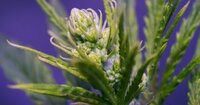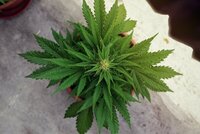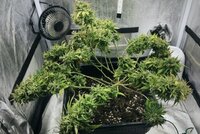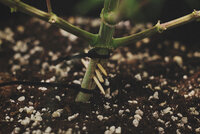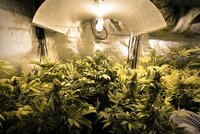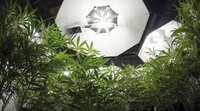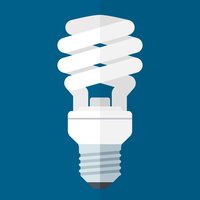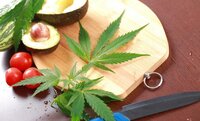- Thread starter
- #181
DrCannaCanadian
Well-Known Member
Hey 420!
Based on what I am seeing, the two Seedsman Peyote WiFis are going to be killer plants! I transplanted them both today into their final homes - 5 gallon coco fabric pots. Since they are strong, I only expect them to take two days to recover!
When I transplanted them, I took care to make sure the LST I applied is straightening their stems.
Why? Because cannabis plants grow best with straight thick stems!
Here's a few shots of their primary stems - anchored and straight:
Also, when they were transplanted, they both got a full feeding to 10% run-off - which basically sets the coco up for accepting good growth for the roots.
Warning: Never ever plant into coco which has not been properly prepared!
Unlike soil, there is no need to add microlife, because there is nothing for the microlife to chew on - and all the nutes are coming in a ready-to-use state.
The plants in soil do get root mass expanders - because there is food for the critters to chomp on and break down into smaller usable molecules.
At this stage, when the plants are young, I typically just feed them water or foliar them with water - that way I hope to avoid overfertilization and root rot!
I will also start to water the edges of the soil in an attempt to draw the roots out laterally. And in general, we let soil nearly dry out - the plants actually like that, and it triggers the roots to stretch out searching for water.
We want roots to chase water!
Alright, we'll save more theory for another day.
And here they are Jedis and friends growing happily under the power of a Mars Hydro TSL 2000 light:
Based on what I am seeing, the two Seedsman Peyote WiFis are going to be killer plants! I transplanted them both today into their final homes - 5 gallon coco fabric pots. Since they are strong, I only expect them to take two days to recover!
When I transplanted them, I took care to make sure the LST I applied is straightening their stems.
Why? Because cannabis plants grow best with straight thick stems!
Here's a few shots of their primary stems - anchored and straight:
Dagobah Frost Forest - Princess Leia
Peyote WiFi - Coco/Perlite - Veg Day 12. Basic LST keeping the stem straight and growth nodes...
Dagobah Frost Forest - Obi-Wan Kenobi
Peyote WiFi - Coco/Perlite - Veg Day 12. Basic LST keeping the stem straight and growth nodes...
Also, when they were transplanted, they both got a full feeding to 10% run-off - which basically sets the coco up for accepting good growth for the roots.
Warning: Never ever plant into coco which has not been properly prepared!
Unlike soil, there is no need to add microlife, because there is nothing for the microlife to chew on - and all the nutes are coming in a ready-to-use state.
The plants in soil do get root mass expanders - because there is food for the critters to chomp on and break down into smaller usable molecules.
At this stage, when the plants are young, I typically just feed them water or foliar them with water - that way I hope to avoid overfertilization and root rot!
I will also start to water the edges of the soil in an attempt to draw the roots out laterally. And in general, we let soil nearly dry out - the plants actually like that, and it triggers the roots to stretch out searching for water.
We want roots to chase water!
Alright, we'll save more theory for another day.
And here they are Jedis and friends growing happily under the power of a Mars Hydro TSL 2000 light:
Dagobah Frost Forest - Group Photo
Group Photo - Veg Day 12
Dagobah Frost Forest - Princess Leia
Peyote WiFi - Coco/Perlite - Veg Day 12
Dagobah Frost Forest - Obi-Wan Kenobi
Peyote WiFi - Coco/Perlite - Veg Day 12
Dagobah Frost Forest - Emperor Sidius
Peyote WiFi - Coco/Perlite - Veg Day 12
Dagobah Frost Forest - Darth Maul
Peyote WiFi - Coco/Perlite - Veg Day 12
Dagobah Frost Forest - Rey
Tangie Cookies - Fox Farm Ocean Forest Soil - Veg Day 12
Dagobah Frost Forest - Chewbacca
Tangie Cookies - Fox Farm Ocean Forest Soil - Veg Day 12
Dagobah Frost Forest - Han Solo
Tangie Cookies - Fox Farm Ocean Forest Soil - Veg Day 12








